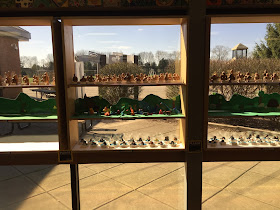Last year, I did some fundraising and wrote a grant in order to buy a 3D printer. My 3D dreams came true and I was able to purchase an Ultimaker 2+. I wound up ordering it last spring, but I didn't plan to use it until this year.
Prior to buying the printer, I hadn't ever used one before. I don't think I had ever seen one other than online pictures. A colleague had purchased one and raved about using it with students.
After I got the printer, I immediately started learning how to use it and figure what it is capable of. 3D printers use a specific type of 3D image file in order to produce the print. Special slicing software takes a 3D image and divides it into hundreds of individual layers that the printer prints. There were several preloaded files that I did test prints with, but I quickly found sites like thingiverse.com that are 3D community sites in which files are available for download and there is plenty of information about printing.
 In addition to learning the hardware, there are various types of software that are available for 3D printers. I'm using a web-based program called Tinkercad. It is free to sign up and is pretty easy for students to learn. They have a whole series of tutorials that I used to learn the software. I wound up setting up 30 different accounts that my students share. I have a few students in each class who have set up their own accounts at home as well. The best part about Tinkercad being web-based is that students are able to access it from home if they really want to put extra time into their work.
In addition to learning the hardware, there are various types of software that are available for 3D printers. I'm using a web-based program called Tinkercad. It is free to sign up and is pretty easy for students to learn. They have a whole series of tutorials that I used to learn the software. I wound up setting up 30 different accounts that my students share. I have a few students in each class who have set up their own accounts at home as well. The best part about Tinkercad being web-based is that students are able to access it from home if they really want to put extra time into their work.
You might be asking yourself why I would put a 3D printer in an elementary art room. In my opinion, it's just another tool to be creative with. Students still use creativity to come up with their own designs. The computer just becomes another form of media. I have about 250 4th and 5th graders that are currently working on laptops in order to create their designs. Touching on my last post about choice, I set up three loose categories that students can work within. Students choose between creating dream houses/buildings, transportation, or figurines. The open choice stumped a few students, but the majority have been able to come up with pretty solid ideas to build off of. We started with a day of sketching, then did a training day with Tinkercad. I'm giving each class 4-5 additional classes to work on their projects before they download the 3D files and send them to me.
 |
| 5th grade piece in progress. His grandfather is a pilot and he's making him a model of the plane he flies. |
This project has been a really nice change of pace in so many ways. It's nice to having something so different going on in my classroom. Using Tinkercad is new and exciting for the students, so they are incredibly engaged in what they are doing. It has also given students another way to excel in my classroom. Some students who may not be the most artistic kids in the class have really taken off with this project because it uses an entirely different skill set than traditional art making.
 |
| I made a quidditch pitch as my demo piece. I'm cool with how nerdy that is. |
Do any of you have a 3D printer? I'm super interested in hearing about projects that you've come up with to use it. It's truly an amazing technology and I couldn't be more excited to have it in my classroom.
















































